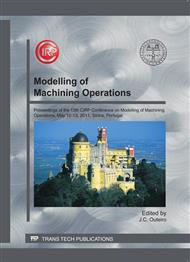p.191
p.203
p.212
p.222
p.231
p.240
p.247
p.257
p.267
Numerical Prediction of the Interface Temperature Using Updated Finite Difference Approach
Abstract:
This investigation is devoted to the heat flow problem occurring in dry orthogonal machining of a C45 medium carbon steel performed with uncoated single-point carbide tools. Finite Difference Approach (FDA) is applied to predict the variations of temperature distribution, and both average and maximum temperatures at the tool-chip interface, resulting from differentiating the heat flux configuration, and additionally the changes of thermal resistance along the tool-chip contact length. Moreover, some realistic computing errors due to possible measuring variations of the tool-chip contact length and the density and dimension of heat source on the shear plane were assessed and considered as input data in simulations. Finally, the measured values of temperatures using natural tool-work thermocouples have confirmed that the models proposed predict acceptably the average interface temperatures and estimate their maximum values for carbide tools.
Info:
Periodical:
Pages:
231-239
Citation:
Online since:
April 2011
Authors:
Keywords:
Price:
Сopyright:
© 2011 Trans Tech Publications Ltd. All Rights Reserved
Share:
Citation:


